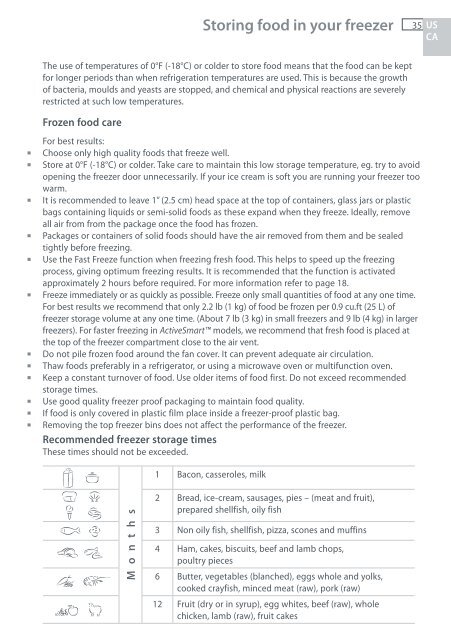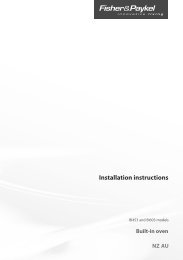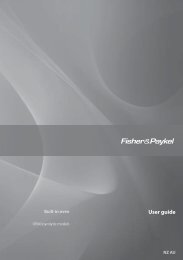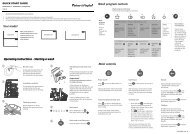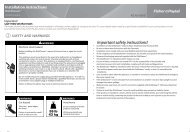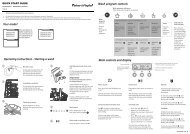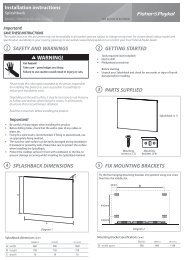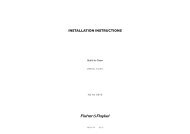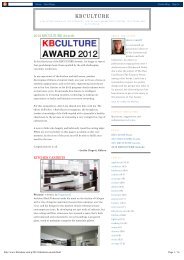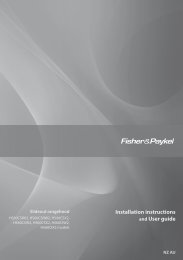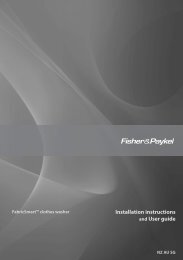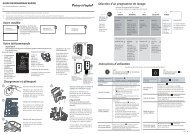Installation instructions and User guide Instructions ... - Fisher & Paykel
Installation instructions and User guide Instructions ... - Fisher & Paykel
Installation instructions and User guide Instructions ... - Fisher & Paykel
You also want an ePaper? Increase the reach of your titles
YUMPU automatically turns print PDFs into web optimized ePapers that Google loves.
Storing food in your freezer<br />
The use of temperatures of 0°F (-18°C) or colder to store food means that the food can be kept<br />
for longer periods than when refrigeration temperatures are used. This is because the growth<br />
of bacteria, moulds <strong>and</strong> yeasts are stopped, <strong>and</strong> chemical <strong>and</strong> physical reactions are severely<br />
restricted at such low temperatures.<br />
Frozen food care<br />
For best results:<br />
■■ Choose only high quality foods that freeze well.<br />
■■ Store at 0°F (-18°C) or colder. Take care to maintain this low storage temperature, eg. try to avoid<br />
opening the freezer door unnecessarily. If your ice cream is soft you are running your freezer too<br />
warm.<br />
■■ It is recommended to leave 1” (2.5 cm) head space at the top of containers, glass jars or plastic<br />
bags containing liquids or semi-solid foods as these exp<strong>and</strong> when they freeze. Ideally, remove<br />
all air from from the package once the food has frozen.<br />
■■ Packages or containers of solid foods should have the air removed from them <strong>and</strong> be sealed<br />
tightly before freezing.<br />
■■ Use the Fast Freeze function when freezing fresh food. This helps to speed up the freezing<br />
process, giving optimum freezing results. It is recommended that the function is activated<br />
approximately 2 hours before required. For more information refer to page 18.<br />
■■ Freeze immediately or as quickly as possible. Freeze only small quantities of food at any one time.<br />
For best results we recommend that only 2.2 lb (1 kg) of food be frozen per 0.9 cu.ft (25 L) of<br />
freezer storage volume at any one time. (About 7 lb (3 kg) in small freezers <strong>and</strong> 9 lb (4 kg) in larger<br />
freezers). For faster freezing in ActiveSmart models, we recommend that fresh food is placed at<br />
the top of the freezer compartment close to the air vent.<br />
■■ Do not pile frozen food around the fan cover. It can prevent adequate air circulation.<br />
■■ Thaw foods preferably in a refrigerator, or using a microwave oven or multifunction oven.<br />
■■ Keep a constant turnover of food. Use older items of food first. Do not exceed recommended<br />
storage times.<br />
■■ Use good quality freezer proof packaging to maintain food quality.<br />
■■ If food is only covered in plastic film place inside a freezer-proof plastic bag.<br />
■■ Removing the top freezer bins does not affect the performance of the freezer.<br />
Recommended freezer storage times<br />
These times should not be exceeded.<br />
M o n t h s<br />
1 Bacon, casseroles, milk<br />
2 Bread, ice-cream, sausages, pies – (meat <strong>and</strong> fruit),<br />
prepared shellfish, oily fish<br />
3 Non oily fish, shellfish, pizza, scones <strong>and</strong> muffins<br />
4 Ham, cakes, biscuits, beef <strong>and</strong> lamb chops,<br />
poultry pieces<br />
6 Butter, vegetables (blanched), eggs whole <strong>and</strong> yolks,<br />
cooked crayfish, minced meat (raw), pork (raw)<br />
12 Fruit (dry or in syrup), egg whites, beef (raw), whole<br />
chicken, lamb (raw), fruit cakes<br />
35 US<br />
CA


